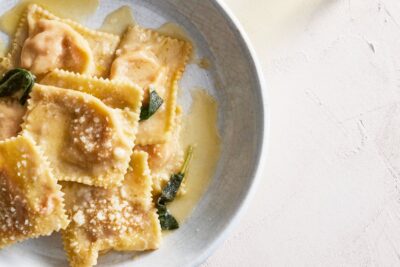Lidia Bastianich’s recipe for Pumpkin Ravioli, a fall dish using butternut squash
By Canadian Press on November 19, 2025.

Lidia Bastianich notes that the traditional filling of pumpkin ravioli is simple. Instead of the traditional roasted Mantova squash, she uses butternut here and says it’s a good substitute. She also uses crushed amaretti cookies, breadcrumbs, eggs, and grated Grana Padano or Parmigiano Reggiano, so the filling is not too sweet. In the northern Italian city of Mantova, they add mostarda di Mantova, a chutney of preserved local fruit in syrup. It’s usually a combination of pears, apricots, and cherries with some mustard powder added, which makes it piquant. Here, Bastianich substitutes golden raisins.
This recipe is reprinted from the 2025 book “Lidia’s The Art of Pasta”:
Pumpkin Ravioli
Serves: 6
Makes 24 to 30 ravioli
For the Ravioli
1/2 small butternut squash (about 1 pound), split lengthwise, seeds removed
1 tablespoon extra-virgin olive oil
Kosher salt
⅓ cup golden raisins, coarsely chopped if large
1/2 cup freshly grated Grana Padano or Parmigiano Reggiano
¼ cup fine dry breadcrumbs
¼ teaspoon freshly grated nutmeg
1 recipe Fresh Pasta with Just a Few Eggs (recipe follows)
All-purpose flour, for rolling
For the Sauce
6 tablespoons unsalted butter
10 large fresh sage leaves
Kosher salt
1/2 cup freshly grated Grana Padano or Parmigiano Reggiano
Directions
1. To make the ravioli, preheat the oven to 400 degrees. Put the squash into a baking dish, and drizzle the cut side with the olive oil. Season with 1 teaspoon salt. Turn it over; place it, cut side down, in the baking dish, and add 1 cup water. Cover the dish with foil, and bake for 30 minutes. Remove the foil, and continue to bake until the squash is completely tender when pierced with a knife, 15 to 20 minutes more. Remove it from the oven, and let it cool.
2. Meanwhile, put the raisins into a small bowl, and add hot water to cover. Let them soak for 10 minutes, then drain them and pat them very dry.
3. When the squash has cooled, scoop the flesh into a large bowl. Mash it well with a potato masher; you should have about 1 heaping cup. Add the drained raisins, grated cheese, breadcrumbs, nutmeg, and ¼ teaspoon salt. Mix well to make a cohesive filling.
4. To make the ravioli, cut the dough into four pieces; work with one piece at a time, and keep the others covered with a damp kitchen towel. Flatten a piece of the dough with your palm, and then roll it through a pasta machine on the widest setting. Fold the dough like a letter to square it off and roll it through again, putting the wider end through first. Continue to roll it, at progressively narrower settings, always keeping the dough lightly floured, until you’ve created a long strip, as wide as your machine allows, and a little less than ⅛ inch thick. Repeat with the remaining dough. (If the strips get too long to work with, cut them in half crosswise before proceeding.)
5. Fill a small bowl with water. Lay one strip of dough in front of you with the long side facing you. Drop 1-tablespoon balls of filling at about 1 1/2-inch intervals along the bottom half of the dough strip. Use your finger or a pastry brush to brush water around the sides of the filling, and fold the top of the dough strip over, covering all of the mounds of filling. Press around the filling to seal it in and remove air bubbles. Use a serrated pastry wheel (or a regular one if you don’t have a serrated one) to cut between the mounds, and roll the cutter along the bottom of the strip to cut off any excess dough. Transfer the cut ravioli to floured baking sheets, and repeat with the remaining dough and filling. You should get about twenty- four to thirty ravioli. They’re ready to cook, but can also be frozen to use later. To freeze, place the baking sheets directly into the freezer. Once the ravioli are frozen solid, transfer them to resealable plastic bags for longer storage.
6. When you are ready to cook, bring a large pot of salted water to a boil for the pasta.
7. To make the sauce, melt the butter in a large skillet over medium heat. Once the butter begins to melt, add the ravioli to the boiling water. Scatter the sage leaves into the melted butter and let them sizzle for a minute to flavor the butter. Ladle in 1 cup pasta- cooking water, and simmer while the ravioli cook. Cook the ravioli until they’re al dente, 3 to 4 minutes, depending on how thick you’ve rolled them. Gently transfer them with a spider to the simmering sauce. Toss gently to coat the ravioli in the sauce, adding a little more pasta water if it seems dry. Season with salt if needed. Remove the skillet from the heat. Sprinkle the ravioli with the grated cheese, toss, and serve immediately.
NOTE: The choice of squash is very important. The local variety used in Mantova is large in size and bright orange in color, with a firm and compact pulp and high sugar content. The peel is extremely thick, with green streaks, and it looks puffed out and sectioned like a peeled orange. Besides butternut, which I use here, you can also try blue Hokkaido pumpkin, kabocha squash, or Long Island cheese pumpkins.
Fresh pasta with just a few eggs (from ravioli ingredients list above)
Pasta can be made from just flour and water, but eggs can be added to enrich the texture and enhance the color and flavor. In leaner times, just a few eggs were used. My grandmother would use two whole eggs to make pasta for 10 people, whereas in Bologna — “La Grassa” (“The Fat”) — which is known for making the richest and best egg pasta in Italy, only egg yolks and flour are used to make the pasta. Of course, it is golden yellow, rich, and delicious.
Makes about 1 pound
Ingredients
2 cups all-purpose flour, plus more as needed
1 teaspoon kosher salt
2 large eggs
¼ cup extra-virgin olive oil
3 tablespoons ice-cold water, plus more as needed
Directions
1. To make the dough with a food processor, put the flour and salt into the bowl of a food processor, and process for a few seconds to aerate the mixture. Whisk the eggs, olive oil, and water in a spouted measuring cup to combine them. With the food processor running, pour in the wet ingredients through the feed tube. Process for about 30 to 40 seconds, until a dough forms and gathers on the blade. If the dough does not gather on the blade or process easily, it is too wet or too dry. Feel the dough, then work in more flour or ice water, in small amounts, using the processor or kneading by hand. Turn the dough out on a lightly floured surface, and knead it by hand for a minute, until it’s smooth, soft, and stretchy (but not sticky).
2. To make the dough by hand, combine the flour and salt in a large bowl. Whisk the eggs, olive oil, and water in a spouted measuring cup to combine them. Make a well in the center of the flour, and add the mixed wet ingredients. Mix with a fork until the dough comes together in rough clumps. Flour your hands, and squeeze and knead the dough right in the bowl until you’ve formed a cohesive mass. Transfer the dough to a lightly floured work surface, and knead until it’s smooth, soft, and stretchy (but not sticky), 3 to 6 minutes, depending on the strength and speed of your kneading. Just as with the food- processor dough, adjust with a little bit of flour or water, as needed, at the beginning of the kneading stage.
3. Press the dough into a disk, wrap it well in plastic wrap, and let it rest at room temperature for at least 1/2 hour. (You can refrigerate the dough for up to a day, or freeze it for a month or more. Defrost it in the refrigerator, and return it to room temperature, before rolling it.)
___
From “Lidia’s The Art of Pasta” (copyright) 2025 by Tutti a Tavola, LLC. Excerpted by permission of Alfred A. Knopf, a division of Penguin Random House LLC. All rights reserved. No part of this excerpt may be reproduced or reprinted without permission in writing from the publisher.
The Associated Press
-47

